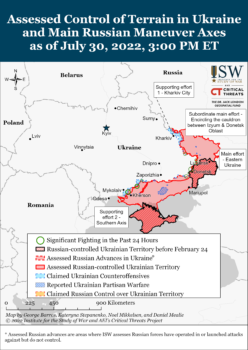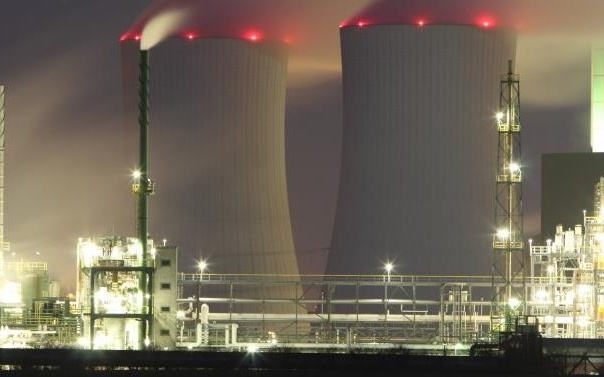The Zaporizhzhia nuclear power in southeast Ukraine amid shelling by Russian forces, March 4, 2022
Friday’s Coverage: Kyiv “Shaping The Course For The 1st Time”

Source: Institute for the Study of War
UPDATE 1722 GMT:
Entrepreneur Anna Vorosheva, a former detainee, has spoken of conditions in the prison where about 53 Ukrainian POWs were killed by an explosion on July 29.
The Olenivka facility is in a Russian proxy area in the Donetsk region in eastern Ukraine. Russia and its proxy, the “Donetsk People’s Republic”, are suspected of slaying the detainee and trying to blame the killing on shelling by the Ukrainian military.
Vorosheva spent 100 days in Olenivka after she was detained in mid-March at a checkpoint run by the DPR.
She recounted screams from soldiers being tortured, inhuman conditions in overcrowded cells, inedible gruel for food, and no communication with the outside world.
Recovering in France, Vorosheva says that she is certain Russia “cynically and deliberately” murdered the POWs.
We are talking about absolute evil….
Russia didn’t want them to stay alive. I’m sure some of those “killed” in the explosion were already corpses. It was a convenient way of accounting for the fact they had been tortured to death.
UPDATE 1638 GMT:
The European Union has condemned Russia’s use of the Zaporizhzhia nuclear power plant as a base, including its firing on Ukraine-held areas.
The EU’s foreign policy head Josep Borrell tweeted:
The EU condemns Russia’s military activities around #Zaporizhzhia nuclear power plant. This is a serious and irresponsible breach of nuclear safety rules and another example of Russia’s disregard for international norms. @iaeaorg must gain access.
— Josep Borrell Fontelles (@JosepBorrellF) August 6, 2022
The head of the International Atomic Energy Agency, Rafael Grossi, said:
I’m extremely concerned by the shelling yesterday at Europe’s largest nuclear power plant, which underlines the very real risk of a nuclear disaster that could threaten public health and the environment in Ukraine and beyond….
Any military firepower directed at or from the facility would amount to playing with fire, with potentially catastrophic consequences.
UPDATE 1015 GMT:
Russia’s authorities have arrested a third leading scientist on a charge of treason.
Dr Alexander Shiplyuk, director of the Siberian Branach of the Institute of Theoretical and Applied Mechanics of the Russian Academy of Sciences, has been sent to the Lefortovo pre-trial detention center in Moscow.
Shiplyuk heads a technology lab with wind tunnels purpose-built for simulating hypersonic conditions.
On June 27, the chief researcher of the institute, Anatoly Maslov, was detained on suspicion of transferring state secret data related to hypersonic missiles. Some reports said he was sending the material to China.
Three days later, Dmitry Kolker, a researcher at the Institute of Laser Physics of the Siberian Branch of the Russian Academy of Sciences, arrested. He also was accused of collaborating with Chinese security services.
Suffering from stage 4 cancer, Kolker died while being transferred from the pre-trial detention center.
UPDATE 0954 GMT:
Oksana Pokalchuk, the head of Amnesty Ukraine, has resigned in protest over Amnesty International’s report about the Ukrainian military and civilian areas.
Amnesty International said on Thursday that Ukrainian forces had established bases and weapons systems in residential areas, including in schools and hospitals.
The report has been sharply criticized by Ukrainian officials, including President Volodymyr Zelenskiy, and Western diplomats. Amnesty Ukraine said it was not given access to any material and not allowed to make any input, adding:
Every person from the Ukrainian Amnesty office knows that the Russian Federation is responsible for the crimes of aggression against Ukraine. Moreover, a large part of our team are people who personally had to save themselves and loved ones from the war with Russia, leaving everything behind. Some of us have already been displaced or refugees twice.
Pokalchuk wrote on Facebook that her analysis was “deleted” and replaced by Amnesty International with its summary in Thursday’s report. She amplified the critique of Amnesty Ukraine:
If you don’t live in a country invaded by invaders and are tearing it to pieces, you probably don’t understand what it’s like to condemn an army of defenders. And there are no words in any language that can convey this to someone who has not felt this pain.
UPDATE 0703 GMT:
Ukrainian officials say Russia’s military is using drones provided by Iran.
Presidential advisor Oleksiy Arestovych claimed Tehran, which regularly boasts about its advanced drone technology, has delivered 46 UAVs to Moscow and that some are already operational in combat.
Some of the UAVs are older-generation “Shahed 129” heavy strike drones, with which Russia may try to attack US-made HIMARS medium-range rocket systems in Ukraine.
UPDATE 0604 GMT:
Vladimir Putin hosted Turkish President Recep Tayyip Erdoğan on Friday in the Black Sea resort city of Sochi in southern Russia.
Few details were given about the discussions, expected to focus on the Russian invasion of Ukraine, sanctions on Moscow, and Turkey’s ambitions in northern Syria.
The two leaders’ agreement to develop “energy cooperation” followed a report by the Ukrainian Government report, circulated by the Washington Post, that Putin is seeking Russian stakes in Turkish refineries, terminals, and reservoirs. That could help disguise the origin of Russian oil exports, circumventing the European Union’s planned cutoff of Moscow’s oil by the end of the year.
The Post also reported that Russia is seeking correspondent accounts for large Russian banks to bypass financial sanctions.
Putin referred to the TurkStream pipeline, saying it had continued operating “smoothly … in contrast to every other route supplying our hydrocarbons”. Erdoğan referred to plans for a Turkish nuclear power plant to be built with Russian assistance.
The Russian leader courted Erdoğan by thanking him for Turkey’s brokering of the deal over Ukrainian Black Sea ports, lifting Russia’s five-month blockade: “This is a very pressing problem for many countries, first and foremost, the developing ones that are on the brink of big problems with food and fertiliser supply. The decisions made with your direct participation are very important for all these countries.”
See also Ukraine War, Day 161: 1st Ukrainian Grain Ship Reaches Turkey
There was no direct reference to tension between the two countries over Erdoğan’s threat to launch more Turkish cross-border military operations into northern Syria. Instead, the two leaders “reaffirmed their determination to act in coordination and solidarity in the fight against all terrorist organizations”.
The Turkish President, seeking re-election next year, is seeking the control of additional territory in the Kurdish-controlled area of the divided country. However, that expansion would challenge Russia, which is propping up the Assad regime’s hold on most of Syria.
Just over two weeks ago, at a tripartite summit with Iran, Erdoğan publicly snubbed Putin, making the Russian leader wait for their meeting in Tehran.
ORIGINAL ENTRY: Ukraine’s officials say Russian forces have carried out strikes near a reactor at the Zaporizhzhia nuclear complex, the largest in Europe.
Ukraine’s State-run nuclear operator Energoatom said in a statement: “The Russian military again resorted to provocation….Three strikes were recorded on the site of the plant, near one of the power blocks where the nuclear reactor is located.”
Explosions in and around plant at about 2:30 p.m. on Friday destroyed electrical transmission lines, forcing engineers to alter the operation of one of the six reactors by reducing power, Energoatom said.
Hours later, a second series of three explosions damaged an auxiliary building near a reactor, raising the risk of hydrogen leaks and fire.
Three reactors at the plant were operational, two were on standby, and one was undergoing planned repairs.
Dmytro Orlov, a former plant engineer and mayor of Enerhodar, where the plant is located, said, “This is an unusual event but not unpredictable. Personnel were prepared.”
Hiding Among the Reactors
Russian forces occupied the complex in southern Ukraine in the opening days of their February 24 invasion. The plant has six of the country’s 15 reactors.
The Ukraine military says Russian forces at the site are involved in the regular bombardment of Nikopol, to the west across the Dnipro River. UK military intelligence assessed on Friday morning that Russian troops “have likely undermined the security” of the plant by using it as a base.
The International Atomic Energy Agency warned earlier this week of the Russians using Zaporizhzhia to attack, basing the firing positions amid the reactors as a shield against any Ukrainian response.
Ukraine President Volodymyr Zelenskiy said in his nightly address to the nation:
This is the largest nuclear power plant on our continent, and any shelling of this facility is an open, brazen crime, an act of terror.
Russia should bear responsibility for the very fact of creating a threat to the nuclear power plant.
The Russian Defense Ministry insisted that Ukrainian forces had shelled the plant.
Last month, Ukraine’s military intelligence agency said a precision-guided “kamikaze” drone destroyed a Russian rocket launcher and air defense system, located about 150 yards from a reactor, without damaging the reactor itself.

